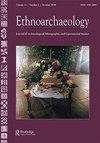埃塞俄比亚与咖啡有关的陶器传统的生活史:民族考古学和考古记录的形成过程
IF 1.3
0 ARCHAEOLOGY
引用次数: 0
摘要
阿拉比卡咖啡是全球消费最广泛的咖啡品种,是埃塞俄比亚最优秀的国产咖啡。具有讽刺意味的是,关于这种植物在其原产地的早期种植和消费的考古研究很少。这项对埃塞俄比亚西南部Kafecho、Majangir和Oromo咖啡生产社区的民族考古研究考察了与咖啡相关的陶器从系统到考古背景的过程。冲泡咖啡的两种传统与两种不同的陶器组合有关。不同家庭中与咖啡有关的陶器的生活史的差异可归因于:(1)破碎模式的差异,这种模式可以允许或禁止二次使用;(2)家庭经济状况,这决定了陶器何时被更换。在生产咖啡的社区中,与咖啡有关的陶器的使用、再利用和丢弃率很高,在被丢弃的二次垃圾和被废弃的定居点作为主要垃圾被丢弃的可能性很高。本文章由计算机程序翻译,如有差异,请以英文原文为准。
The Life History of Coffee-Related Pottery Traditions in Ethiopia: Ethnoarchaeology and Formation Processes of the Archaeological Record
ABSTRACT Coffea arabica, the most widely consumed variety of coffee globally, is the Ethiopian domesticate par excellence. Ironically, archaeological research on the early cultivation and consumption of this plant in its place of origin is sparse. This ethnoarchaeological study among Kafecho, Majangir, and Oromo coffee-producing communities in southwest Ethiopia examines the processes by which coffee-related pottery moves from systemic to archaeological contexts. Two traditions of brewing coffee are associated with two different pottery assemblages. Variation in the life history of coffee-related pottery across households is attributed to (1) differences in breakage patterns that either enable or inhibit secondary use and (2) household economic status, which determines when pottery is replaced. The use, reuse, and discard of coffee-related pottery is high in coffee-producing communities, and the possibility of recovering such remains archaeologically is high in midden sites where secondary refuse is discarded and in abandoned settlements as primary refuse where breakage occurs.
求助全文
通过发布文献求助,成功后即可免费获取论文全文。
去求助
来源期刊

Ethnoarchaeology
ARCHAEOLOGY-
CiteScore
1.60
自引率
0.00%
发文量
10
期刊介绍:
Ethnoarchaeology, a cross-cultural peer-reviewed journal, focuses on the present position, impact of, and future prospects of ethnoarchaeological and experimental studies approaches to anthropological research. The primary goal of this journal is to provide practitioners with an intellectual platform to showcase and appraise current research and theoretical and methodological directions for the 21st century. Although there has been an exponential increase in ethnoarchaeological and experimental research in the past thirty years, there is little that unifies or defines our subdiscipline. Ethnoarchaeology addresses this need, exploring what distinguishes ethnoarchaeological and experimental approaches, what methods connect practitioners, and what unique suite of research attributes we contribute to the better understanding of the human condition. In addition to research articles, the journal publishes book and other media reviews, periodic theme issues, and position statements by noted scholars.
 求助内容:
求助内容: 应助结果提醒方式:
应助结果提醒方式:


